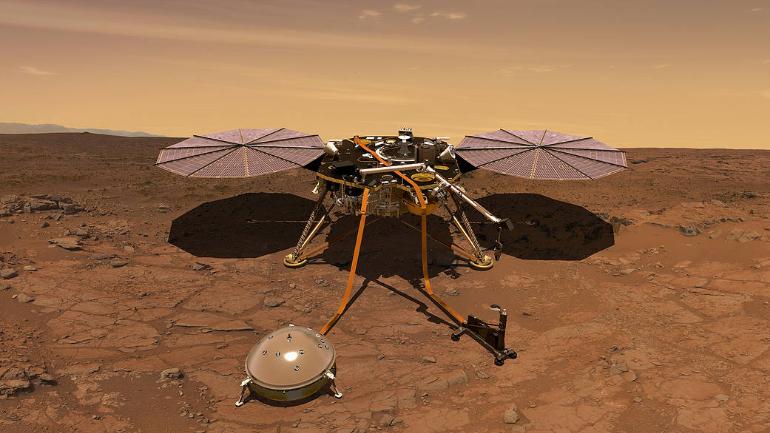Nasa InSight: Craft lands on Mars to go where no man has ever gone

CAPE CANAVERAL, Nov 27, 2018, India Today. Nasa’s first spacecraft built to explore the deep interior of another world landed on a vast, barren plain on Mars on Monday, carrying instruments to detect planetary heat and seismic rumblings never measured anywhere but Earth, reported the India Today.
Flight controllers at NASA’s Jet Propulsion Laboratory in Pasadena, California, leapt out of their seats and erupted in screams, applause and laughter as the news came in. “Touchdown confirmed!” a flight controller announced.
They announced that the spacecraft InSight touched down Monday, after a perilous supersonic descent through the red Martian skies. Confirmation came via radio signals that took more than eight minutes to cross the nearly 100 million miles (160 million kilometres) between Mars and Earth.
A pair of mini satellites trailing InSight since their May liftoff provided practically real-time updates of the spacecraft’s supersonic descent through the reddish skies. The satellite also shot back a quick photo from Mars’ surface.
Its new home is Elysium Planitia, a still, flat region where it’s set to study seismic waves and heat deep below the surface of the Red Planet for a planned two-year mission.
The craft sent an image from its new home. The image was marred by specks of debris. But the quick look at the surroundings showed a flat surface with few if any rocks just what scientists were hoping for. Much better pictures will arrive in the hours and days ahead.

US Vice-President Mike Pence also congratulated Nasa on the successful landing.
The mission control team at Nasa’s Jet Propulsion Laboratory (JPL) near Los Angeles conducted a final adjustment to the InSight’s flight path on Sunday to steer the spacecraft closer to its target arrival point over Mars.
“What a relief”, said JPL’s chief engineer, Rob Manning. This is really fantastic. He added: “Wow! This never gets old.”
Manning said the landing appeared to be “flawless”.
“This is what we really hoped and imagined in our mind’s eye, he said. Sometimes things work out in your favour.”
It is Nasa’s eighth successful Mars landing since the 1976 Vikings. Three-legged, one-armed InSight will operate from the same spot for the next two years. It landed less than 400 miles (600 kilometres) from NASA’s Curiosity rover, which until Monday was the youngest working robot in town.
The smaller, 880-pound (360 kg) InSight – its name is short for Interior Exploration Using Seismic Investigations, Geodesy and Heat Transport – marks the 21st US-launched Mars missions, dating back to the Mariner fly-bys of the 1960s. Nearly two dozen other Mars missions have been sent from other nations.
InSight will spend 24 months – about one Martian year – using seismic monitoring and underground temperature readings to unlock mysteries about how Mars formed and, by extension, the origins of the Earth and other rocky planets of the inner solar system.
InSight’s primary instrument is a French-built seismometer, designed to record the slightest vibrations from “marsquakes” and meteor impacts around the planet. The device, to be placed on the surface by the lander’s robot arm, is so sensitive it can measure a seismic wave just one half the radius of a hydrogen atom.
Scientists expect to see a dozen to 100 marsquakes during the mission, producing data to help them deduce the depth, density and composition of the planet’s core, the rocky mantle surrounding it, and the outermost layer, the crust.
Nasa officials say it will take two to three months for the main instruments to be deployed and put into operation.
By examining the interior of Mars, scientists hope to understand how our solar system’s rocky planets formed 4.5 billion years ago and why they turned out so different — Mars cold and dry, Venus and Mercury burning hot, and Earth hospitable to life.
InSight has no life-detecting capability, however. That will be left to future rovers. NASA’s Mars 2020 mission, for instance, will collect rocks that will eventually be brought back to Earth and analyzed for evidence of ancient life.